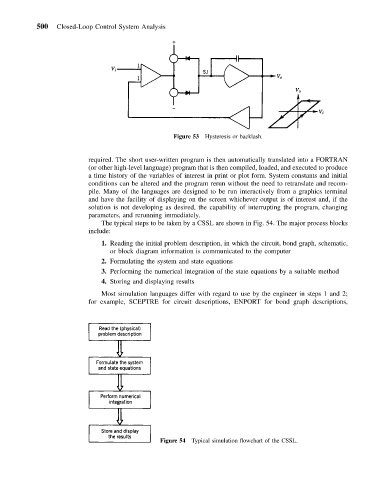Page 509 - Mechanical Engineers' Handbook (Volume 2)
P. 509
500 Closed-Loop Control System Analysis
Figure 53 Hysteresis or backlash.
required. The short user-written program is then automatically translated into a FORTRAN
(or other high-level language) program that is then compiled, loaded, and executed to produce
a time history of the variables of interest in print or plot form. System constants and initial
conditions can be altered and the program rerun without the need to retranslate and recom-
pile. Many of the languages are designed to be run interactively from a graphics terminal
and have the facility of displaying on the screen whichever output is of interest and, if the
solution is not developing as desired, the capability of interrupting the program, changing
parameters, and rerunning immediately.
The typical steps to be taken by a CSSL are shown in Fig. 54. The major process blocks
include:
1. Reading the initial problem description, in which the circuit, bond graph, schematic,
or block diagram information is communicated to the computer
2. Formulating the system and state equations
3. Performing the numerical integration of the state equations by a suitable method
4. Storing and displaying results
Most simulation languages differ with regard to use by the engineer in steps 1 and 2;
for example, SCEPTRE for circuit descriptions, ENPORT for bond graph descriptions,
Figure 54 Typical simulation flowchart of the CSSL.

